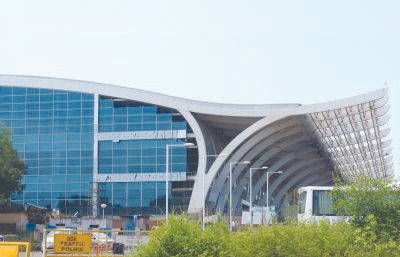
Dabolim Airport’s turbulent battle for the skies
The beautiful landscape of Goa has long been associated with sun-kissed beaches, vibrant nightlife, and a thriving tourism industry. At the heart of this experience is Dabolim International Airport, a vital gateway connecting Goa to the world.
However, recent developments have cast a shadow over Dabolim’s future, raising concerns among stakeholders and prompting a closer examination of its sustainability in the face of changing dynamics. In recent months, Dabolim International Airport, has found itself at the epicenter of a burgeoning sustainability issue.
The future of Dabolim International Airport has been cast into uncertainty, sparking concerns from various stakeholders. The catalyst for this concern stems from the shifting landscape of international airlines to the new Manohar International Airport, Mopa.
A shift in the skies
The ripple effect of this relocation has raised alarms, prompting the Goa Chamber of Commerce and Industry (GCCI) to express apprehensions about the future of Dabolim airport and expressing worries about the potential closure of this Airport. GCCI has taken the lead in expressing apprehensions about the potential closure of the airport, citing a 20% decline in passenger footfall and the relocation of international airlines to the new Manohar International Airport in Mopa. Qatar Airways’ decision to discontinue flights from Dabolim and shift operations to Mopa by June 19 has further fueled apprehensions.
This shift not only poses a threat to the livelihoods of those involved but also raises questions about the sustainability and growth of Dabolim. GCCI has penned a letter to Prime Minister Narendra Modi and Chief Minister Dr Pramod Sawant, urging them to intervene and halt further airline relocations to Mopa.
Seeking solutions and equitable charges
The industry body emphasises that if major operations cease at Dabolim, it could set off a chain reaction leading to the closure of other services and, ultimately, the airport itself. To address these concerns, GCCI advocates for a meeting involving relevant stakeholders, including government officials, airline representatives, and local communities, to collaboratively find solutions ensuring the continuity and growth of Dabolim Airport.
One of the key issues raised by the GCCI is the need for alignment in User Development Charges (UDF) for both Mopa and Dabolim airports. Currently, Dabolim’s UDF is higher than Mopa’s, creating an imbalance that could deter stakeholders.
The Airport Economic Regulatory Authority (AERA) has approved a hike in Dabolim’s UDF to Rs. 1,791 for 2025-26, compared to Mopa’s Rs. 840. Moreover, parking fees for aircraft at Dabolim have seen a 40% annual increase. GCCI believes that rationalising UDF and other charges, coupled with facility improvements, will make Dabolim more attractive to stakeholders, thus fostering its overall development.
The Director’s perspective
The concerns raised by GCCI are echoed by the director of Goa International Airport, Dabolim, S V T Dhanamjay Rao. He notes a significant decline in passenger footfall, attributed to international airlines relocating to Mopa. Despite the challenges, Rao remains optimistic about the Dabolim airport’s potential for growth. He assures that charters continue to operate, and no domestic airlines are considering a move to Mopa. Rao, however, acknowledges the anticipated reduction in passenger numbers, from 8.4 million last year to around 7 million this year, due to airline relocations. Rao’s optimism stems from the airport’s enduring potential and growth prospects. He anticipates additional flights during the summer and dismisses doubts about Dabolim Airport’s viability.
Assurances from the Chief Minister
In response to the apprehensions surrounding Dabolim Airport, Chief Minister Dr Pramod Sawant stepped into the fray, assuring that Dabolim International Airport will not face closure. He highlighted the significant investment of over Rs. 500 crore by the Airport Authority of India (AAI) in Dabolim’s infrastructure, emphasising the coexistence of Dabolim with the new Mopa airport. Dr Sawant dismissed fears of closure and addressed concerns about the Indian Navy taking over, stating that private companies cannot exert pressure on them. He referred to the Union Cabinet’s decision to continue commercial operations at Dabolim and assured that revenue from Mopa airport operations will benefit the state starting May 2024, as per the agreement with GMR Goa International Airport. Notably, since Dabolim is managed by AAI, the state does not currently receive revenue from it. Dr. Sawant reassured that Dabolim will co-exist with the new Mopa airport.
The Goa Assembly during its recent sessions witnessed a heated debate over Dabolim’s future, with members expressing concerns about the decline in passengers since Mopa’s opening. Dr. Sawant confirms previous assurances made by three former Chief Ministers regarding Dabolim’s operations.
Calls for equal treatment
However, members, including Fatorda MLA Vijai Sardesai, highlight a drop in flight operations and increased user development fees at Dabolim. Sardesai alleged a plan to shut it down and demanded equal fees at both airports.Amidst the assurances, concerns raised by members of the assembly persist.
Curtorim MLA Aleixo Reginaldo Lourenco questioned the decline in flight movements and passenger traffic, while Fatorda MLA Vijai Sardesai highlighted increased user development fees at Dabolim. Sardesai alleged a plan to shut down Dabolim and demanded equal fees at both airports.
The call for parity in fees is echoed by GCCI, adding weight to the argument that aligning charges between Mopa and Dabolim will contribute to the latter’s sustained growth. The need for government intervention and a collaborative approach involving all stakeholders has become increasingly evident in navigating the challenges posed by the shifting dynamics of the aviation landscape in Goa.
Where are the skies headed?
The coming months will undoubtedly be crucial in determining whether Dabolim can weather the storm and continue to be a symbol of connectivity for Goa.
The calls for collaboration among government officials, airline representatives, and local communities, coupled with addressing issues such as user development charges and facility improvements, will be crucial in determining the airport’s fate.
As the debate continues, the future of Dabolim remains a significant point of contention and a story to watch in the evolving landscape of aviation in Goa.





